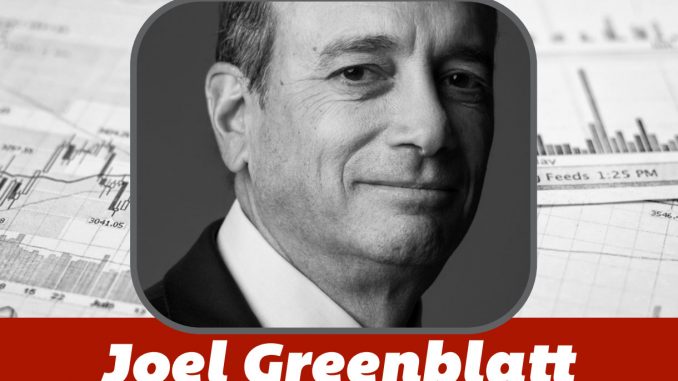
Surely, there are a lot of great amazing investing books out there in the world, leaving you with the need to re-read the book over and over again but there is not any single book that I would recommend for Stock Market Investing. I have read numerous ones on and relating to Stock Investing and learned a lot from them but the book I’m going to review now influenced me a lot when it comes to value investing. I would not falter to say, somehow this book manages to take a place in my personal all-time-favorite book’s list.
The Little Book That Beats The Market, by Joel Greenblatt, is probably the most simple and influential value investing book ever written. SmartMoney described it as “The book unquestionably makes good on its promises.”
He is also funny. I read this book quite 1 year ago and I can still remember how I was excited to read another page. I finish it up in just a couple of days. His sarcastic language made the book funny, easy and simple enough to understand value investing nerdy concepts.
This book will take readers on a step-by-step journey so that they can learn the principles of value investing in a way that will provide them with a long-term strategy that they can understand and stick with through both good and bad periods for the stock market.
It’s written in plain English and 6th-grade math to make it easy to follow along. This is the strong point of the Magic Formula theme.
In it’s most naked form, the Magic Formula is described by Greenblatt as
A long-term investment strategy designed to help investors buy a group of above-average companies but only when they are available at below-average prices.
However, he wrote nothing new about value investing, he just followed Benjamin Graham but in a simple manner. Initially, Greenblatt wrote this book for his children who were aged between 6-15 at the time but the simplicity of the book made it all time best seller of New York Times with over 300,000 copies in print.
Book was first published in 2005. Later, in 2010, it was updated with a new Introduction and Afterwords. The new version covering the data and analysis of the financial crisis and model performance through the end of 2009.
The book was started with a guy Jason, who use to earn 25 cents on every chewing gum packet he sold since 6th grade which later turn into a company with millions of shares. Maybe you got a glimpse on how he laid down the plot to make his strategy understandable to readers in this 208 pages book.
Over the years, market developments have proven the wisdom of Greenblatt’s strategies. In the book he had considered 17 years period to prove whether the formula worked in the past and of course, his magic formula beat the market with a great margin.
Yet the story is not ended. He also inserted his efforts to explain why this formula will keep working forever. You can locate a strip written “still” on the book cover (Go on, scroll up and see). Its books cover was designed in a way to depict that not only it worked in past, its still working and will keep working for decades.
Think of it yourself, why a business earning high and available at cheap rates could become a bad investment? I’m not able to figure out why it’s riskier to buy a business valued $100 million dollars for $50 million. No matter, at what phase the company is currently sustaining. Instead, it has a good value and great future.
Let me put it in summarized way – What Joel would have you consider, in effect, is a basket of stocks which are good business at a low valuation. And he has a simple way for you to find them.
Here’s a glimpse of his formula:
THE MAGIC FORMULA: ROIC & EARNINGS YIELD
In his book, Greenblatt presents a “Magic Formula” for buying good companies at good prices. These concepts – good company and good price – are represented by two ratios from companies’ financial statements:
- Return on Invested Capital (ROIC) represents “good company”
- Earnings Yield represents “good price”.
Here is the technical definition of both ratios, plus a quick way to think about them:
Return on Invested Capital (ROIC) = (Earnings Before Interest & Taxes + Depreciation – CapEx) / (Net Working Capital + Net Fixed Assets)
This tells you how much cash a company generates in relation to the amount of capital tied up in its business. As ROIC numbers increase, all else being equal, a business gets better and better. The reason is that when you own a business, the higher your ROIC, the more money you are able to pocket every year in relation to the money you have invested in the business.
Earnings Yield = (Earnings Before Interest & Taxes + Depreciation – CapEx) / Enterprise Value (Market Value + Debt – Cash)
This tells you how expensive a company is in relation to the earnings the company generates. When looking at Earnings Yield, we make certain adjustments to a company’s market capitalization to estimate what it would take to buy the entire company. This involves penalizing companies that have a lot of debt and rewarding others that have a lot of cash.
There’s something more…
He also summed up to find a good business in qualitative terms. Below is an extract from the book:
“………..of course, there are plenty of ways we could define what makes a business either good or bad. Among other things, we could look at the quality of its products or services, the loyalty of its customers, the value of its brands, the efficiency of its operations, the talent of its management, the strength of its competitors, or the long term prospectus of its business. Obviously, any of these criteria, either alone or combination, would be helpful in evaluating weather we were purchasing a good or a bad business. All of these assessments would also involve making guesses, estimates, and/or predictions. As we already agreed, that’s a pretty hard thing to do……….”
Not everyone can beat the averages, of course – by definition. But my guess is that the patient people who follow Joel’s advice for at least 3 to 5 years can beat the market averages with more than 100%.
Hold on! What will happen if millions of book readers will adopt this simple strategy?
2 things will happen. First, the advantage of this way will diminish but not disappear. Second, stock market valuations will become ever so slightly more rational which in turn will make our capital allocation process slightly efficient.
Truly speaking, it’s not possible (that million of people adopt this strategy). Why so?
The only problem is most people don’t have the time or ability to analyze companies. Even if the person has time and ability, here comes Emotional barrier;
To follow the value investing approach, you’re pretty much forced to buy out-of-favor companies that no one who reads the newspaper or watch CNBC would think of buying.
Also, it may possible that the value stock may not perform negatively or not satisfactory for months. So it would be hard to see your portfolio underperform the market for months. At the end, this leads one to back to trend investing.
Instead of giving more emphasis on this magic formula, Mr. Greenblatt, again and again, kept saying to have faith on formula. When I was reading this book, I thought – Is it a philosophical book? saying us to have faith on magic formula, if you want it to work but as I read more and more, I found his words meaningful.
He had also built a free resource website of stock screener specially designed for finding companies on the basis of his Magic Formula.
Site link: magicformulainvesting.com
I don’t want to spoil the excitement of reading this excellent book. So let me stop my review with the testimonials of many influencers.
Testimonials
“Simply perfect. One of the most important investment books of the last 50 years!”
Michael Price
“A landmark book a stunningly simple and low–risk way to significantly beat the market!”
Michael Steinhardt (the Dean of Wall Street hedge fund managers).
“This book is the finest simple distillation of modern value investing principles ever written. It should be mandatory reading for all serious investors from the fourth grade on up.”
Professor Bruce Greenwald (Director of the Heilbrunn Center for Graham and Dodd Investing, Columbia Business School)
“Greenblatt delivers admirably . . . it contains one of the clearest, most entertaining explanations you′ll ever see of the ideas underlying value investing.”
International Herald Tribune
About the Author (of book):

JOEL GREENBLATT is the founder of Gotham Capital, an investment partnership that achieved 40% annualized returns for the 20 years after its founding in 1985. He is a professor on the adjunet faculty of Columbia Business School, the Chief Strategist for Formula Investing, the former chairman of the board of a Fortune 500 company, and the author of You Can Be a Stock Market Genious and The Little Book That Still Beat The Market. Greenblatt holds a BS and an MBA from Wharton School.

